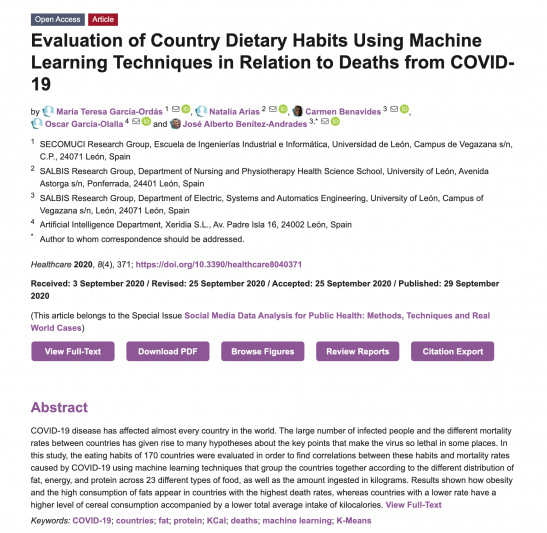Evaluation of Country Dietary Habits Using Machine Learning Techniques in Relation to Deaths from COVID-19
1 SECOMUCI Research Group, Escuela de Ingenierías Industrial e Informática, Universidad de León, Campus de Vegazana s/n, C.P., 24071 León, Spain
2 SALBIS Research Group, Department of Nursing and Physiotherapy Health Science School, University of León, Avenida Astorga s/n, Ponferrada, 24401 León, Spain
3 SALBIS Research Group, Department of Electric, Systems and Automatics Engineering, University of León, Campus of Vegazana s/n, León, 24071 León, Spain
4 Artificial Intelligence Department, Xeridia S.L., Av. Padre Isla 16, 24002 León, Spain
* Author to whom correspondence should be addressed.
Healthcare 2020, 8(4), 371; https://doi.org/10.3390/healthcare8040371
Received: 3 September 2020 / Revised: 25 September 2020 / Accepted: 25 September 2020 / Published: 29 September 2020
(This article belongs to the Special Issue Social Media Data Analysis for Public Health: Methods, Techniques and Real World Cases)
COVID-19 disease has affected almost every country in the world. The large number of infected people and the different mortality rates between countries has given rise to many hypotheses about the key points that make the virus so lethal in some places. In this study, the eating habits of 170 countries were evaluated in order to find correlations between these habits and mortality rates caused by COVID-19 using machine learning techniques that group the countries together according to the different distribution of fat, energy, and protein across 23 different types of food, as well as the amount ingested in kilograms. Results shown how obesity and the high consumption of fats appear in countries with the highest death rates, whereas countries with a lower rate have a higher level of cereal consumption accompanied by a lower total average intake of kilocalories. View Full-Text

